Is it all garbage anyway?
How to properly dispose of our packaging!
How to become a recycling pro with Hartkorn How to hausmüll
Incinerable waste, organic waste, recyclables, or paper bin? Do you also sometimes stand clueless in front of your household waste, wondering which item belongs in which bin? How to properly separate the garbage and correctly dispose of food packaging? Don’t worry, you’re not alone! And so that you never have to ask yourself this question again with our spice packaging, we provide you with Hartkorn How to Hausmüll, a guide that clears up all doubts!
Spice Shakers – The Classics in the Aluminum Can

Small, colorful, and quite practical! The aluminum can is the absolute classic among Hartkorn spice shakers – after all, it has been part of our range since 1979. But where to put the shaker when pepper and salt, thyme, or Magic Spice are used up? We’d be happy to explain:
- Ideally, you separate the plastic lid, including the sieve insert, from the aluminum can. We must admit that this can be a little tricky.
- Remove the label from the can.
- Simply throw both the lid and the label, along with the can, into the recyclable waste bin. Why both components end up in the same bin in the end and why that also makes sense will be explained in the FAQs.
Would you have known: Aluminum can be recycled really well and even multiple times – without any loss of quality!
Young Kitchen – The Young Wild Ones in Paper and Cork
Young Kitchen stands for exciting spice blends and absolute trendy dishes – but also for innovative and environmentally friendly packaging. Safely stored in a paper spice jar and sealed with a cork lid, the spices in this line guarantee lots of fun in the kitchen, no matter how good of a cook you are. But where should the empty jar go after you’ve used up the pepper and salt, thyme, or Magic Spice? Let us explain:
- Separate the cork lid and the paper wrap jar.
- As it is a genuine natural product, you can dispose of the cork lid without any worries in the organic waste. Alternatively, you can take it to a cork collection point.
- The spice jar, along with the paper label, goes into the paper recycling. From there, it can embark on a new life.

Gourmet Spices – The Exquisite Ones in Glass
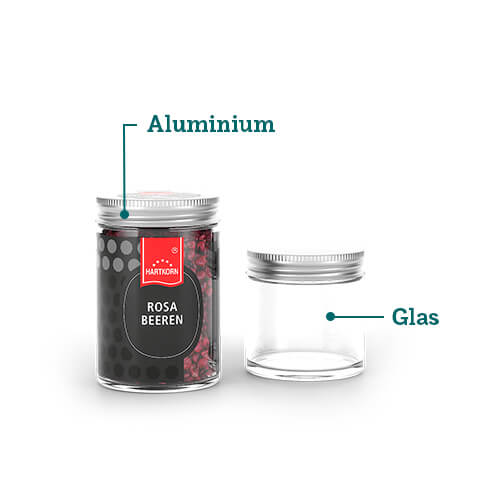
Spice enjoyment in glass, that’s what Hartkorn Gourmet Spices offer you. In addition to freeze-dried herbs, you can also find real specialties like cubeb pepper or Kampot pepper and truffle salt. But how do you dispose of the gourmet jars properly once you’ve used up the last crumb of your favorite spice for cooking? Here’s how:
- Separate the lid from the glass.
- As the lid consists of aluminum and has a plastic insert (EPE), you can conveniently dispose of it in the recyclable waste bin.
- The glass belongs in the appropriate glass container. So, take it with you the next time you go to the glass recycling. Make sure to dispose of glass in the right container because, as with everything else, proper separation is half recycled.
You should know that with separate disposal of glass and lid, the recyclability of gourmet jars is nearly 100%. It’s worth the minimal effort, isn’t it?
Shake’n Grill – The Grill Highlights in a Tin Can
Fish, meat, or vegetables – what do you prefer to put on the grill? It doesn’t matter because with Shake’n Grill blends, you’ll always be on point! And as delicious as these grill spices are, their packaging made of tinplate is just as easy to dispose of.
You don’t need to separate or sort anything. The whole can simply goes into your domestic recyclable waste bin. From there, it sets off on an eternal cycle of recycling.
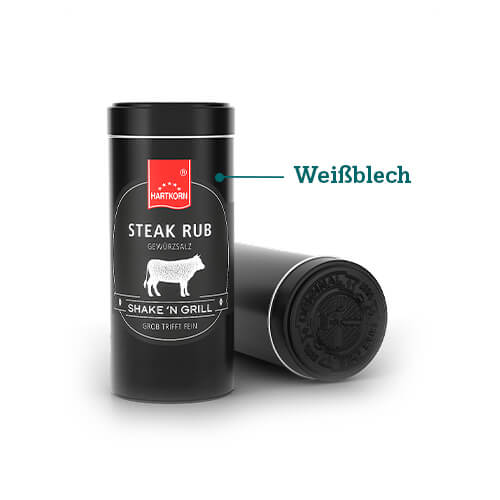
With a recyclability rate of around 98%, the Shake ‘n Grill can is a real hit when it comes to sustainability.
Spice Mills – The Flavor Wonders with a Twist
Let’s twist: In our range, you’ll find three different spice mills. Firstly, there’s the smaller Grind’n Spice mill, then the larger Twist’n Spice spice mill, and lastly, the Bio-Mills. What sets them apart and how you can dispose of these food containers properly, we’ll explain to you gladly.
Grind‘n Spice
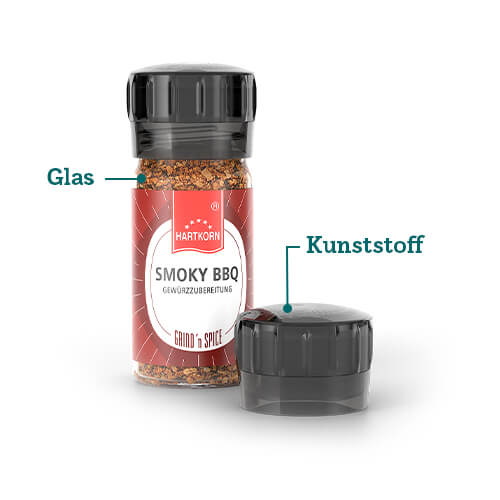
Super handy and perfect for on the go, the Grind’n Spice mills are a practical eye-catcher. But what do you do when it’s all ground up? Since the Grind’n Spice mill is a disposable mill, it now makes its way into the dual system.
- You unscrew the grinder, including the plastic lid, and separate it from the glass body. The lid goes into the recyclable waste bin.
- You take the glass with you the next time you go to the glass container and dispose of it there. And here, too, proper separation is half recycled.
Twist’n Spice
Nothing beats freshly ground spices, right? With our Twist’n Spice mills, you can do just that in a snap, and these practical mills look chic too. And although this section is about household waste and proper disposal of our packaging material, we’d like to give you a heads up that the Twist’n Spice mills are not meant to end up in the bin when empty. Thanks to their high-quality ceramic grinder, they are meant to make many more turns.
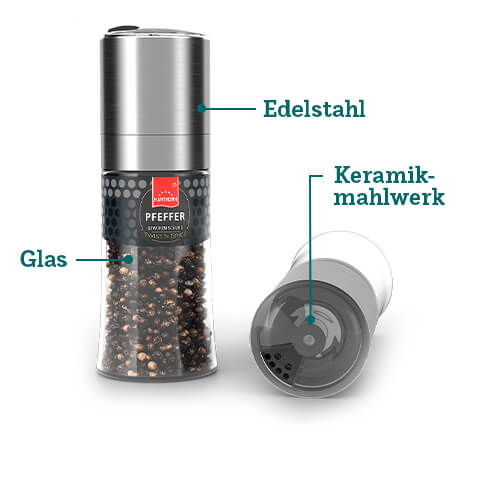
Bio-Mühlen

Bio spice enjoyment fresh from the mill? No problem! Our bio mills made of glass and wood provide pure taste with every turn, and they’re built to last. But what can you do when your spice is used up? For household waste, our bio mill is definitely too good!
So simply and conveniently refill it with our organic spices from the paper can.
Bio Spices – The Sustainable Ones in Paper, Ceramic, and Cork
Ceramic Pot
Are you looking for great spices in an elegant packaging that also has a regional origin? Quite a lot of demands all at once, right? Not a problem for us!
We’ll even top it off: The Hartkorn spices in the ceramic pots from the Westerwald are almost all of organic quality as well. Thanks to the environmentally friendly cork stopper, they are also securely sealed.

And that’s not all. When the fancy pots are empty, you don’t have to dispose of them. It’s much easier to simply refill them with the organic spices from our paper cans.
Bio-Pappdose
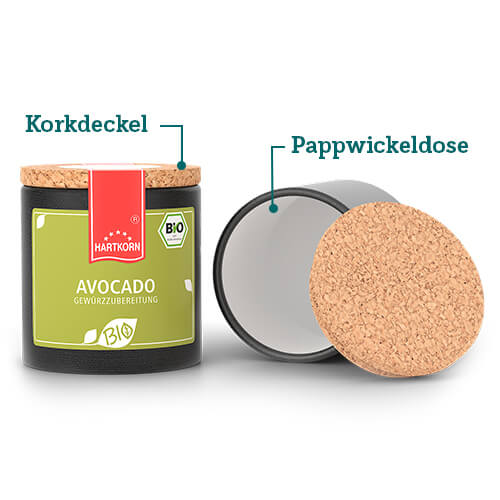
Just like in the Young Kitchen range, the environmentally friendly paper wrap can with a cork lid ensures that our spices are well preserved and protected in our Bio line. Little bonus: the cans also look really chic! But what do you do when your favorite spice is used up? Now, quite simply:
- Separate the cork lid and the paper can.
- As it is a genuine natural product, you can dispose of the cork lid without any worries in the organic waste. Alternatively, you can take it to the nearest cork collection point.
- The spice can, along with the paper label, goes into the paper recycling. From there, it can also set off on a new life.
And if you’re wondering whether there really is such a big difference if you separate the lid and paper can from each other, then the answer is clear: YES! With this type of packaging, separating increases the recyclability by around 40%, resulting in a recycling rate of about 95%. A convincing argument, isn’t it?
Spice Bags – The Practical Refill Option in Paper and Plastic
Refill Bag
What? The mill is empty again, or the spices from the ceramic pot are used up faster than you could blink? Then the practical refill bags are just right! After all, some of our packaging is far too valuable to simply end up in household waste. But where to put the stand-up bags once the spices have been refilled and used up again? You can easily dispose of the food packaging in your recyclable waste bin.

Flat Bag
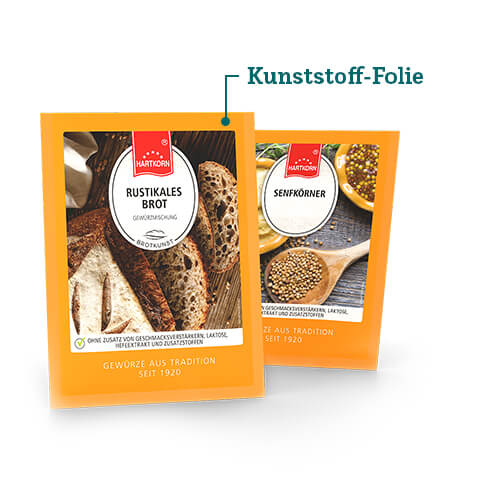
Light- and aroma-protected, the Hartkorn flat bags offer practically portioned classics like nutmeg, our gingerbread spice, or suitable spice blends for baking bread. Once the bag is empty, it simply goes into your recyclable waste bin.
If you want to know why we switched from a composite of plastic film and aluminum to using only plastic film and how that’s a real plus in terms of recyclability, feel free to check out the FAQ.

Now you have received a good overview of which of our spice packagings deserve a long life in your kitchen and which need to be disposed of as household waste. But there is something else that is particularly important to us at this point:
In order for our packagings to be recycled as effectively as possible, we need your help!
Only if you join in and separate the lids, mills, and jars correctly, they will have the best chance of being properly and environmentally friendly processed.
And if you still can’t get enough and want to learn more about our packagings, if you want us to answer questions about the disposal of food packagings, or if you have become a true recycling fan, then take a look at our How-to-Household-Waste FAQ.
